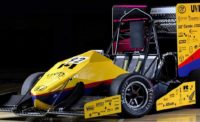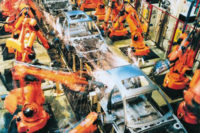When one thinks of Italy, several things immediately come to mind. There’s wine and pasta, world-class soccer and gondoliers singing in Venice. Another thing that symbolizes Italy is Maserati, the manufacturer of technologically advanced sports cars. Founded in 1914, the company operates plants or sales offices in more than 40 countries around the world.
Maserati cars—both old and new—are famous for their luxury design, sporty lines and aggressive engines. The Quattroporte and Ghibli are two of the company’s newer and most popular models. Both are manufactured at Officine Maserati in Grugliasco, near Turin, which reopened in January 2013 after being closed for six years. The facility is also known as the Giovanni Agnelli Plant, having been named after the company’s chairman from 1966 to 1996.
Current plant manager Alberto Filippini says the facility produces 150 vehicles per day (over two shifts) and 50,000 vehicles per year. Flexibility on the sheet metal assembly line is essential to maintaining this high rate of production.
The line is programmed to automatically determine whether the piece is for the Quattroporte or Ghibli, notes Filippini. This is important because the two vehicle bodies differ substantially in terms of chassis length and related components. The line is flexible enough to produce one or both models in a continuous flow.
Workers at the start of the line manually weld and bond three areas of the vehicle using high-strength steel and die-cast aluminum parts, and semi-structural adhesive. These areas are the front framework (where the engine and all related mechanical components are mounted), central floor (front seats, tunnel) and back framework (back seats, trunk).
Next, the vehicle is moved to the automated section featuring 86 robots. There, the robots perform spot welding while inserting subcomponents (brake hoses, underbody parts, wiring) and closing elements (side and top clamp brackets, rivets, Tucker studs). They also precisely fold the flanges of the metal sheets where needed (roller hemming).
After this, the chassis is moved down the line to where the body is added in parallel. The skeleton, or internal part of the side, is fastened first, followed by outer skin. Painting and final assembly are performed soon afterward.
Of the 86 robots used at the plant, 82 are articulated and multiaxis models made by Comau SpA. Novara says Maserati likes Comau robots because they offer quick head changes, a large working area, and high-precision movement when handling parts or performing tasks, such as spreading adhesive. The robots also feature a hollow wrist design that reduces footprint by housing the welding-gun, air-flow and all other cables inside the robot arm.
Overall, each Quattroporte and Ghibli vehicle receives 4,785 welds, 190 rivets and 243 arc-welded studs. More than 1,000 welds are made prior to the sheet metal assembly line, compared to 3,702 welds made on the line. Of these, 1,025 welds are done by hand and 2,677 by robots. The car also requires about 79 meters of adhesive: 13 applied manually and 66 by robot.
For more information on articulated and multiaxis robots, call 248-353-8888 or visit www.comau.com/eng.





